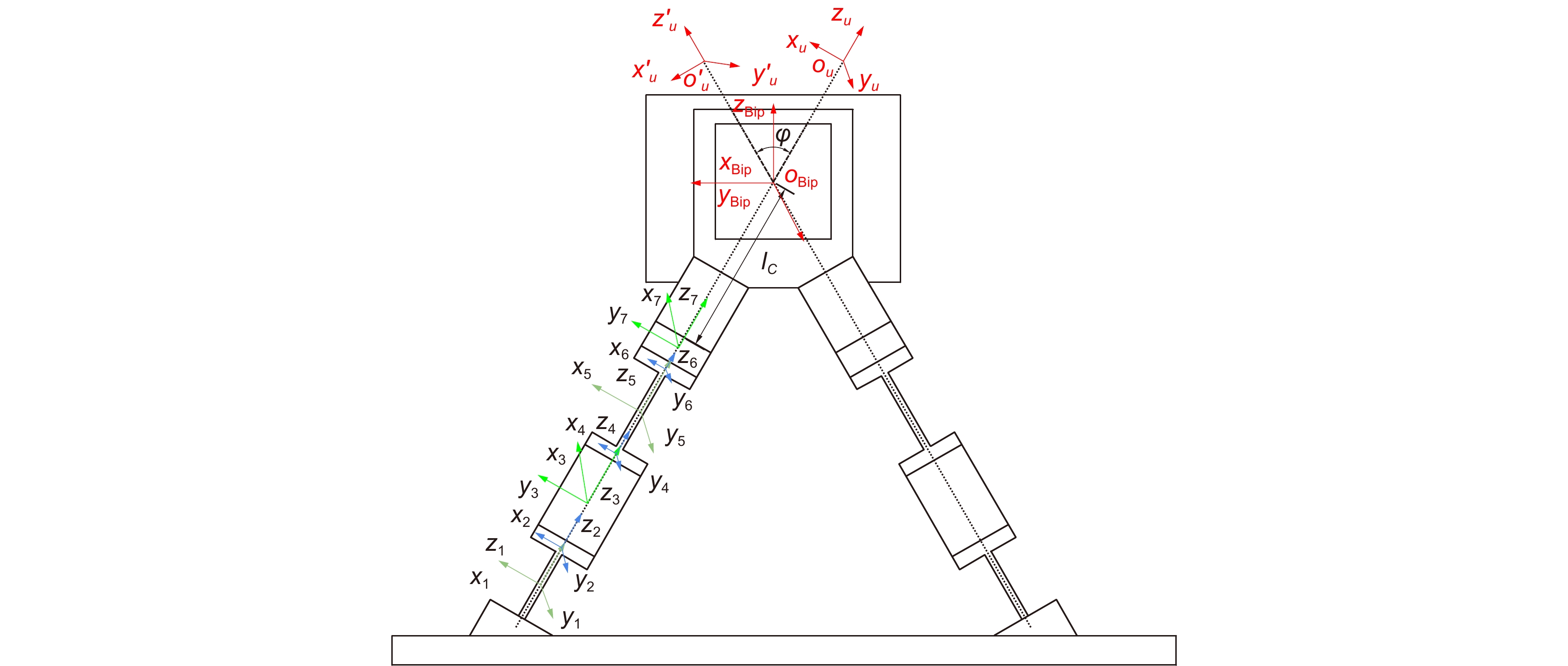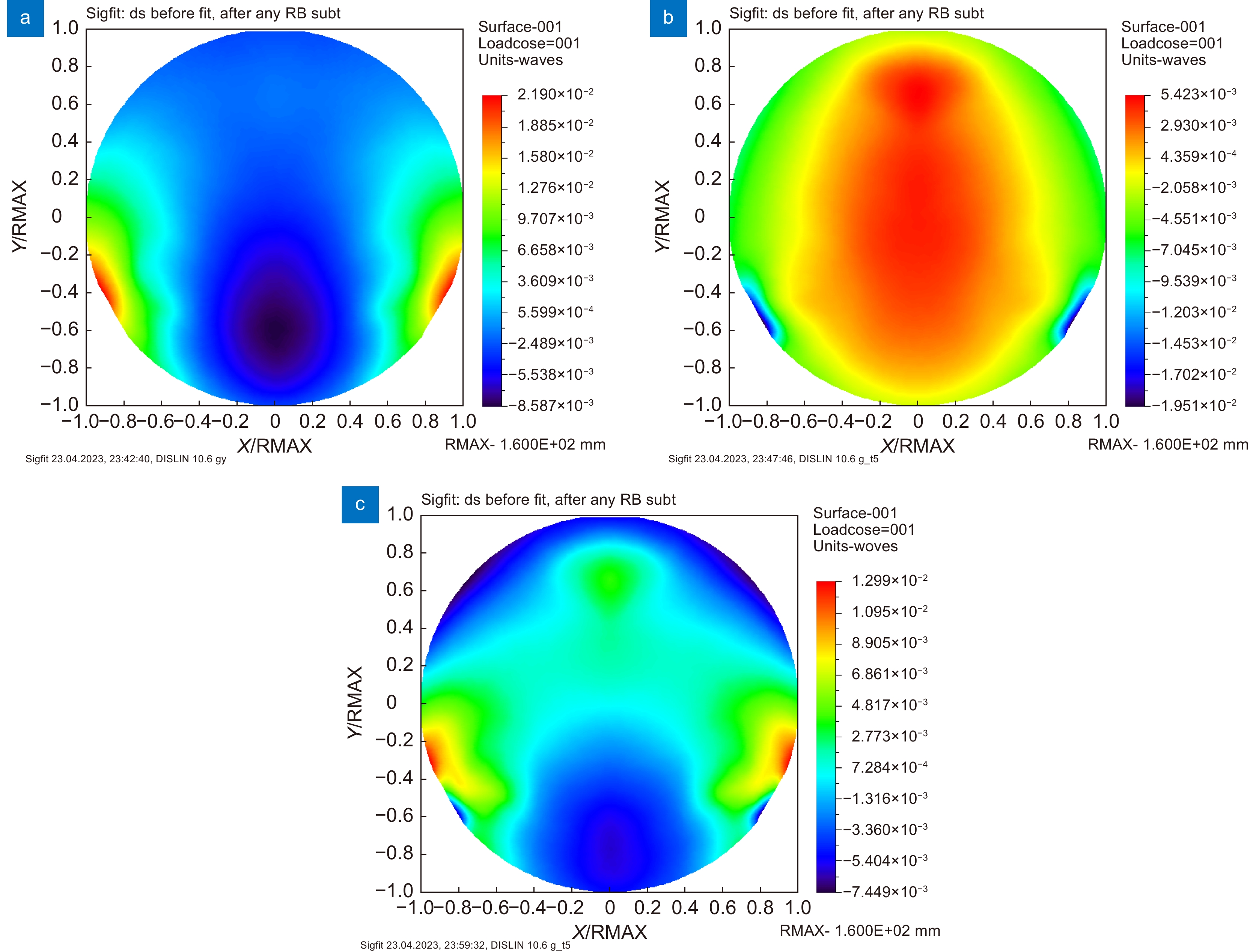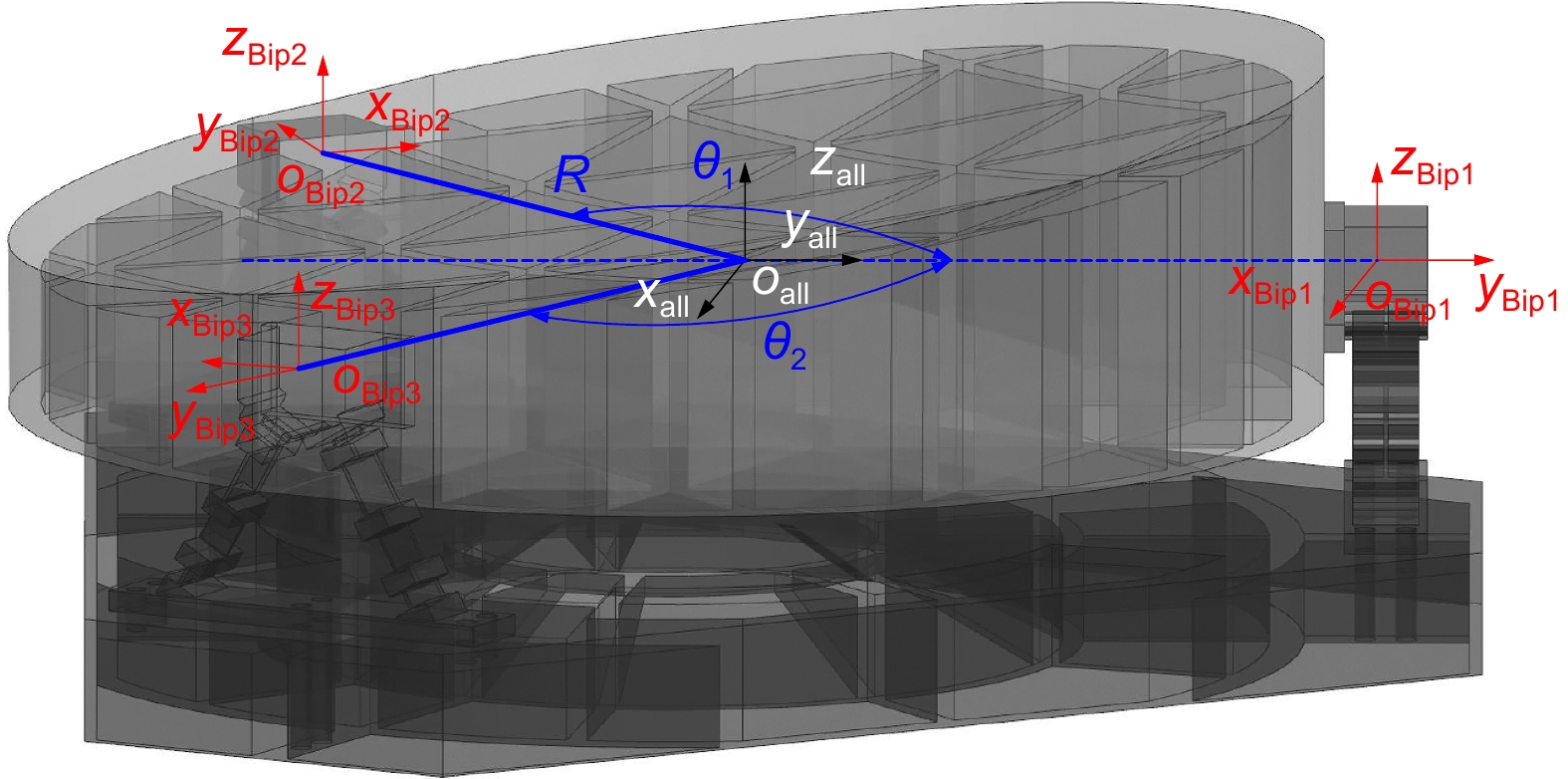Design and thermal stability analysis of primary mirror assembly for space-borne gravitational wave telescope
-
摘要
针对空间引力波探测对望远镜系统提出的皮米级稳定性和
λ /30波前误差的应用需求,提出了一种光机集成分析与优化方法。首先开展了主镜侧支撑点位置分析和支撑结构拓扑优化;然后基于并联Bipod连杆支撑的柔度矩阵,建立了各结构参数的评价函数,并通过Matlab分析初步确定柔性支撑尺寸参数取值范围;最后,搭建了光机集成仿真平台对结构进一步优化。结果表明,系统一阶频率为392.43 Hz,重力和温度载荷下主镜面形变化优于λ /60;在10 μK/Hz1/2的空间热扰动下,主镜组件尺寸稳定性在10 pm/Hz1/2水平。Abstract
In order to meet the application requirements of pimi-level stability and
λ /30 wavefront error in space gravitational wave detection, an optical and mechanical integrated analysis and optimization method is proposed. Firstly, the position analysis of the support points on the main mirror side and the topology optimization of the support structure were carried out. Then, based on the flexibility matrix of parallel Bipod linkage support, the evaluation function of each structure parameter is established, and the value range of flexible support size parameters was preliminarily determined by Matlab analysis. Finally, an integrated optical and mechanical simulation platform was built to further optimize the structure.The results show that the first-order frequency of the system is 392.23 Hz, and the deformation of the primary mirror surface deformation under gravity and temperature loads is better thanλ /60. Under thermal disturbances in a space environment of 10 μK/Hz1/2, the dimensional stability of the primary mirror component is at a level of 10 pm/Hz1/2. -
Overview
Overview: Space gravitational wave detection missions typically consist of three identical satellites, with two laser links between the satellites at an angle of sixty degrees forming a Michelson interferometer. The arm length changes are measured using high-precision inter-satellite laser interferometry. As a key component of the inter-satellite laser interferometry system, the telescope system needs to have picometer-level optical path stability, a wavefront error of λ/30, and stray light less than 10−10 of the transmitted power. To meet the requirements of space gravitational wave detection for the telescope system, an optical and mechanical integrated analysis and optimization method is proposed to design and optimize the primary mirror and its supporting structure. The off-axis parabolic primary mirror adopts the side three-point support method, and the influence of the support point position on the mirror surface shape and the rigid body displacement under gravity conditions has been studied. Optimization of the size of the triangular lightweighting holes on the primary mirror has been performed, and density-based topology optimization has been used to optimize the support backplate while ensuring that the first-order mode of the primary mirror component remains essentially unchanged. The flexural matrix of the primary mirror component supported by a parallel bipod linkage structure was derived based on spinor theory, and an evaluation function for the support structure was established. The size parameter range of flexible support was preliminarily determined by Matlab analysis. A optical-mechanical integrated simulation platform is set up to optimize the parameters of the support structure using a weighted sum method to convert the multi-objective optimization problem into a single-objective optimization problem. The results showed that the first-order frequency of the primary mirror component system was 392.43 Hz. Under gravity and temperature loads, the deformation of the primary mirror surface was better than λ/60, the translational rigid body displacement was better than 2.5 μm, and the rotational rigid body displacement was better than 0.5 μrad, all of which met the design specifications. Under space thermal disturbance of 10 μK/Hz1/2, the size stability of the primary mirror component, represented by the displacement of the central point of the mirror, was at a level of 10 pm/Hz1/2.
-

-
图 1 望远镜系统示意图。(a) 望远镜光学系统[6];(b) 主镜组件
Figure 1. Schematic diagram of the telescope system. (a) Telescope optical system; (b) Primary mirror assembly
表 1 主镜组件材料属性
Table 1. Properties of primary mirror component materials
Matericals Zerodur 4J36 TC4 Density/(g·cm3) 2.53 8.90 4.44 Poisson ratio 0.24 0.25 0.34 Young's modulus /GPa 90.3 141 109 CTE/(10−6·K−1) 0.01 0.65 9.10 Thermal conductivity/(W·m−1·K−1) 1.31 13.7 6.8 表 2 主镜轻量化筋参数
Table 2. The parameters of the lightweight primary mirror
Name Edge thickness Roof thickness Rib thickness Rib spacing Parm hce hpm ljin lju Range/mm [6, 10] [7, 9] [4, 7] [54, 66] Value/mm 8 8 5 60 表 3 参数优化结果
Table 3. The parameters of the lightweight primary mirror
Parm l1 l2 l3 l4 t1 t2 w1 w2 Range/mm [6, 10] [5, 14] [5, 14] [1, 4] [1, 3] [0.5, 2] [8, 14] [8, 14] Value/mm 8 9 6 2 2 1 10 10 表 4 主镜组件模态分析
Table 4. Modal analysis of primary mirror components
Mode 1 Mode 2 Mode 3 Mode 4 Mode 5 Mode 6 Frequency/Hz 392.43 394.83 722.33 770.50 927.36 994.01 表 5 主镜组件分析结果
Table 5. Primary mirror component analysis results
TX TY TZ RX RY RMS Requirement ≤5 μm ≤5 μm ≤5 μm ≤2.5 μrad ≤2.5 μrad 15 nm G −4.91 nm −1.59 μm −2.404 nm −36.3 nrad 6.64 nrad 5.47 nm T −0.423 nm −1.84 nm −0.714 μm −83.8 nrad 21.9 nrad 3.63 nm G+T −5.34 nm −1.60 μm −0.717 μm −0.120 μrad 28.6 nrad 3.61 nm -
参考文献
[1] Einstein A. Approximative integration of the field equations of gravitation[J]. Sitzungsber Preuss Akad Wiss Berlin (Math Phys), 1916, 1916: 688−696.
[2] Abbott B P, Abbott R, Abbott T D, et al. Observation of gravitational waves from a binary black hole merger[J]. Phys Rev Lett, 2016, 116(6): 061102. doi: 10.1103/PhysRevLett.116.061102
[3] Danzmann K, The LISA Study Team. LISA: laser interferometer space antenna for gravitational wave measurements[J]. Class Quantum Grav, 1996, 13(11A): A247−A250. doi: 10.1088/0264-9381/13/11A/033
[4] Luo J, Chen L S, Duan H Z, et al. TianQin: a space-borne gravitational wave detector[J]. Class Quantum Grav, 2016, 33(3): 035010. doi: 10.1088/0264-9381/33/3/035010
[5] Ruan W H, Guo Z K, Cai R G, et al. Taiji program: gravitational-wave sources[J]. Int J Mod Phys A, 2020, 35(17): 2050075. doi: 10.1142/S0217751X2050075X
[6] 范纹彤, 赵宏超, 范磊, 等. 空间引力波探测望远镜系统技术初步分析[J]. 中山大学学报(自然科学版), 2021, 60(1-2): 178−185. doi: 10.13471/j.cnki.acta.snus.2020.11.02.2020b111
Fan W T, Zhao H C, Fan L, et al. Preliminary analysis of space gravitational wave detection telescope system technology[J]. Acta Sci Nat Univ Sunyatseni, 2021, 60(1-2): 178−185. doi: 10.13471/j.cnki.acta.snus.2020.11.02.2020b111
[7] 王小勇,白绍竣,张倩,等. 空间引力波探测望远镜研究进展[J]. 光电工程, 2023, 50(11): 230219. doi: 10.12086/oee.2023.230219
Wang X Y, Bai S J, Zhang Q, et al. Research progress of telescopes for space-based gravitational wave missions[J]. Opto-Electron Eng, 2023, 50(11): 230219. doi: 10.12086/oee.2023.230219
[8] 李博宏,罗健,丘敏艳,等. 引力波探测望远镜超低热变形桁架支撑结构设计技术[J]. 光电工程, 2023, 50(11): 230155. doi: 10.12086/oee.2023.230155
Li B H, Luo J, Qiu M Y, et al. Design technology of the truss support structure of the ultra-low thermal deformation gravitational wave detection telescope[J]. Opto-Electron Eng, 2023, 50(11): 230155. doi: 10.12086/oee.2023.230155
[9] Livas J, Arsenovic P, Castelluci K, et al. LISA telescope spacer design issues[R]. Washington: NASA Goddard Space Flight Center, 2010.
[10] Sanjuán J, Korytov D, Mueller G, et al. Note: silicon carbide telescope dimensional stability for space-based gravitational wave detectors[J]. Rev Sci Instrum, 2012, 83(11): 116107. doi: 10.1063/1.4767247
[11] Livas J, Blake S, Davis A, et al. Proposed LISA telescope design[R]. Washington: NASA Goddard Space Flight Center, 2019.
[12] Livas J, Derosa R, Keski-Kuha R, et al. Technology development for LISA: the telescope[EB/OL]. Bull Am Phys Soc, 2020, 65. https://absuploads.aps.org/presentation.cfm?pid=18123
[13] 李钰鹏, 王智, 沙巍, 等. Bipod反射镜支撑结构的柔度计算及分析[J]. 光学 精密工程, 2018, 26(7): 1691−1697. doi: 10.3788/OPE.20182607.1691
Li Y P, Wang Z, Sha W, et al. Flexibility calculation and analysis of Bipod reflector support structure[J]. Opt Precis Eng, 2018, 26(7): 1691−1697. doi: 10.3788/OPE.20182607.1691
[14] 李钰鹏, 王智, 沙巍, 等. 空间引力波望远镜主镜组件的结构设计[J]. 红外与激光工程, 2018, 47(8): 0818004. doi: 10.3788/IRLA201847.0818004
Li Y P, Wang Z, Sha W, et al. Structural design of primary mirror subassembly for spatial gravitational wave telescope[J]. Infrared Laser Eng, 2018, 47(8): 0818004. doi: 10.3788/IRLA201847.0818004
[15] 王辰忠, 胡中文, 陈忆, 等. 空间引力波望远镜主反射镜系统的结构设计优化[J]. 红外与激光工程, 2020, 49(7): 20190469. doi: 10.3788/IRLA20190469
Wang C Z, Hu Z W, Chen Y, et al. Structural design optimization of space gravitational wave telescope primary mirror system[J]. Infrared Laser Eng, 2020, 49(7): 20190469. doi: 10.3788/IRLA20190469
[16] Dai J S, Ding X L. Compliance analysis of a three-legged rigidly-connected platform device[J]. J Mech Des, 2006, 128(4): 755−764. doi: 10.1115/1.2202141
[17] Selig J M, Ding X L. A screw theory of Timoshenko beams[J]. J Appl Mech, 2009, 76(3): 031003. doi: 10.1115/1.3063630
[18] 张丽敏, 王富国, 安其昌, 等. Bipod柔性结构在小型反射镜支撑中的应用[J]. 光学 精密工程, 2015, 23(2): 438−443. doi: 10.3788/OPE.20152302.0438
Zhang L M, Wang F G, An Q C, et al. Application of Bipod to supporting structure of minitype reflector[J]. Opt Precis Eng, 2015, 23(2): 438−443. doi: 10.3788/OPE.20152302.0438
[19] Kihm H, Yang H S, Lee Y W. Bipod flexure for 1-m primary mirror system[J]. Rev Sci Instrum, 2014, 85(12): 125101. doi: 10.1063/1.4902151
-
访问统计


 E-mail Alert
E-mail Alert RSS
RSS

 下载:
下载:















